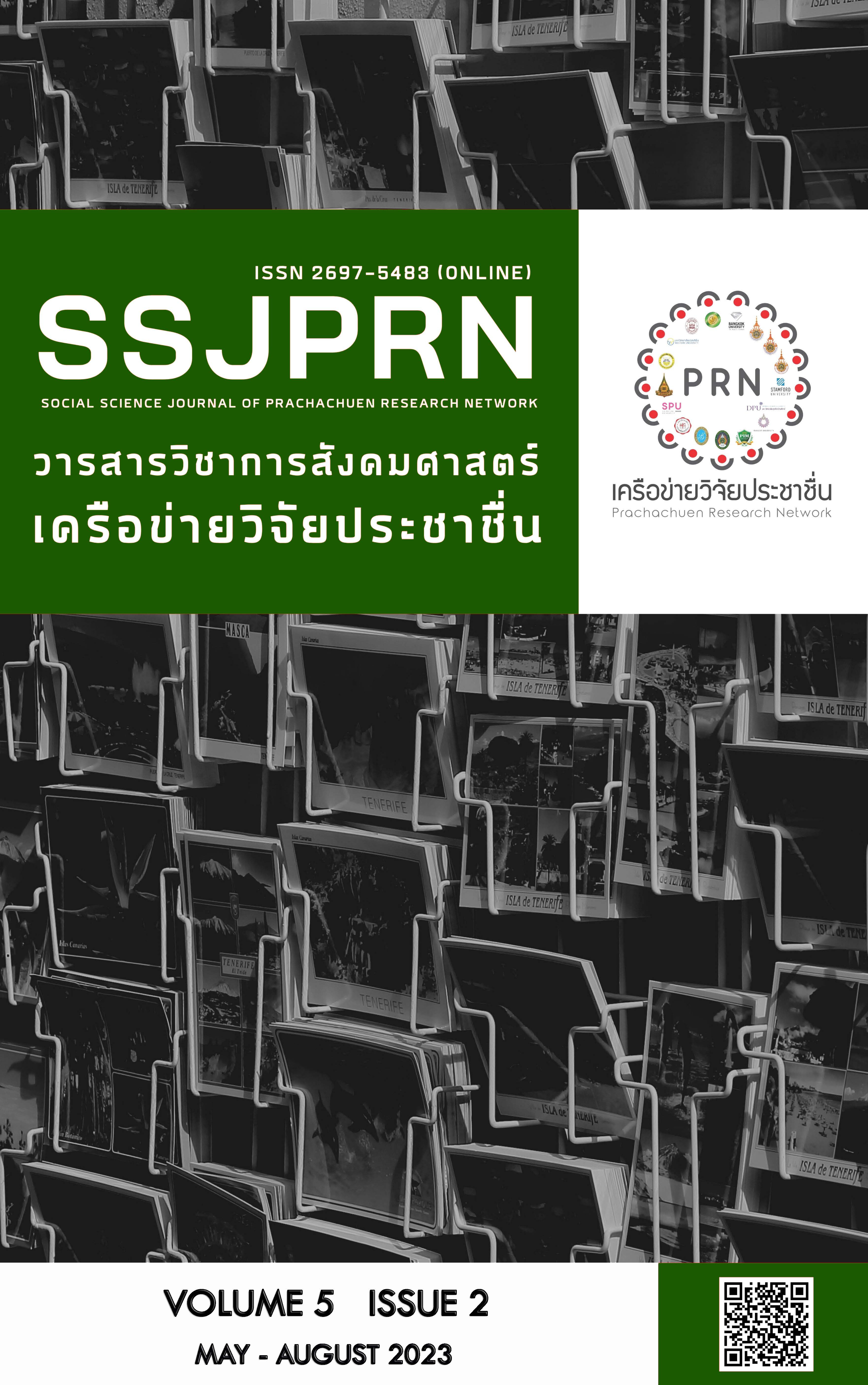A STUDY OF LOGISTICS CAPABILITIES AND LOGISTICS SERVICE QUALITY THAT INFLUENCE LOGISTICS RELATIONSHIPS BETWEEN LOGISTICS SERVICE PROVIDERS AND B2C E-COMMERCE BUSINESSES
Keywords:
Logistics Capability, Logistics Service Quality, Logistics Outsourcing Relationship, B2C Ecommerce, Logistics Service ProvidersAbstract
This study aimed to investigate the effects of logistics capability on operation logistics service quality, relational logistics service quality, and logistics relationships in terms of retention, extension, and referral. The samples were from business-to-consumer (B2C) e-commerce businesses. The online questionnaires were used to collect data from 303 samples based on the convenience sampling technique. The descriptive statistical tools, including frequency, mean, and standard deviation, were used to analyze the data. Moreover, structural equation modeling, utilizing the statistical software: SPSS and AMOS, was used to explore the relationships among the aforementioned factors. The results revealed that the structural equation modeling was aligned with the explicit data at a good fit level. The hypothesis test results showed that the logistics capability had positive effects on the operation logistics service quality and relational logistics service quality at a statistically significant level of .01. Moreover, the operation logistics service quality showed significant positive effects on logistics relationships in terms of retention, extension, and referral at a statistically significant level of .01. The results also showed that the relational logistics service quality had positive effects on logistics relationships in terms of retention but did not have effects on logistics relationships in terms of extension and referral. When analyzing the path analysis, the results revealed that the logistics capability had indirect effects on the logistics relationship in terms of retention, extension, and referral through operation logistics service quality acting as a mediating variable. Nevertheless, logistics capability did not have indirect effects on logistics relationships in terms of retention, extension, and referral.
References
กมลมาลย์ แจ้งล้อม และปุญญภพ ตันติปิฎก. (2563). TRANSPORT and LOGISTICS 2020: อีไอซีวิเคราะห์ธุรกิจขนส่งพัสดุในปี 2020 มีแนวโน้มเติบโตต่อเนื่องท่ามกลางการแข่งขันที่เข้มข้นจากแรงกดดันด้านราคา (Online). สืบค้นจาก https://www.scbeic.com/th/detail/product/6563
ทวีศักดิ์ เทพพิทักษ์. (2552). การตลาดสำหรับธุรกิจบริการ. ชลบุรี: คณะโลจิสติกส์ มหาวิทยาลัยบูรพา.
บูรณ์เมตต์ วิวัฒนานุกูล. (2564). ทำความรู้จักธุรกิจ B2C e-Commerce: รูปแบบธุรกิจ รูปแบบการชำระเงินและวิธีการติดตามภาวะตลาด. กรุงเทพมหานคร: กลุ่มงานพัฒนาสถิติเศรษฐกิจดิจิทัล ธนาคารแห่งประเทศไทย.
วิทยา สุหฤทดำรง. (2549). ลอจิสติกส์การตลาด (Marketing Logistics). กรุงเทพมหานคร: อี.ไอ.สแควร์ พับลิชชิ่ง.
สำนักงานพัฒนาธุรกรรมทางอิเล็กทรอนิกส์. (2564). ETDA เผยมูลค่าอีคอมเมิร์ซไทย ปี 63 อยู่ที่ 3.78 ล้านล้านบาท คาดปี 64 พุ่งไปที่ 4.01 ล้านล้านบาท (Online). สืบค้นจาก https://www.etda.or.th/th/pr-news/ETDA-Reveals-the-Value-of-e-Commerce-in-2021.aspx
Abdul, A., Memon, J. A. & Ali, S. (2020). Logistics Capability, Logistics Outsourcing and Firm Performance in Manufacturing Companies in Pakistan. The Journal of Asian Finance, Economics and Business, 7(8), 435-444.
Akbar, M. M. (2013). Three competing models on customer loyalty in the context of mobile subscribers. International Journal of Marketing Studies, 5(4), 42.
Amit, R. & Schoemaker, P. (1993). Strategic Assets and Organizational Rent. Strategic Management Journal, 14, 33-46.
Baumgartner, H., & Homburg, C. (1996). Applications of structural equation modeling in marketing and consumer research: A review. International journal of Research in Marketing, 13(2), 139-161.
Bentler, P. M. (1990). Comparative fit indexes in structural models. Psychological bulletin, 107(2), 238.
Bienstock, C. C., Mentzer, J. T., & Bird, M. M. (1997). Measuring physical distribution service quality. Journal of the Academy of Marketing Science, 25(1), 31-44.
Bouzaabia, R., Bouzaabia, O., & Capatina, A. (2013). Retail logistics service quality: a cross-cultural survey on customer perceptions. International Journal of Retail and Distribution Management, 41(8), 627-647.
Bowersox, D. J., Closs, D. J., & Stank, T. P. (1999). 21st Century Logistics: Making Supply Chain Integration a Reality. Lombard, IL: Council of Supply Chain Management Professionals.
Brown, I., & Jayakody, R. (2008). B2C e-commerce success: A test and validation of a revised conceptual model. The Electronic Journal Information Systems Evaluation, 11(3), 167-184.
Carmines, E. G. & Zeller, R. A. (1988). Reliability & Validity Assessment. California: Sage.
Chang, H. H., Wang, Y. H., & Yang, W. Y. (2009). The Impact of E-Service Quality, Customer Satisfaction and Loyalty on E-Marketing: Moderating Effect of Perceived Value. Total Quality Management, 20, 423-443.
Cho, J. J., Ozment, J., & Sink, H. L. (2008). Logistics Capability, Logistics Outsourcing and Firm Performance in an E-Commerce Market. International Journal of Physical Distribution & Logistics Management, 38(1), 336-359.
Comrey, A. L., & Lee, H. B. (1992). A first course in factor analysis (2nd ed.). Hillsdale, NJ: Lawrence Erlbaum Associates, Inc.
Erceg, A., & Kilic, Z. (2018). Interconnection Of E-Commerce And Logistics: Examples From Croatia And Turkey. In 18th international scientific conference Business Logistics in Modern Management (pp.265-283). Osijek.
Fernandes, D. W., Moori, R. G., & Filho, V. A. V. (2018). Logistic Service Quality as a Mediator between Logistics Capabilities and Customer Satisfaction. Revista de Gestão, 25(4), 358-372.
Fornell, C., & Larcker, D. F. (1981). Evaluating structural equation models with unobservable variables and measure. Journal of Marketing Research, 18, 39-50.
Hair, J. F., Black, W. C., Babin, B. J., & Anderson, R. E. (2010). Multivariate Data Analysis (7th ed.). USA: PEARSON Prentice Hall.
Haryanto, J. O., & Chang, F. I. (2018). Analysis of e-commerce providers’ role in solving the issues of retail e-commerce logistics in jakarta (study case of pt. Accommerce solusi lestari). Jurnal Manajemen, 22(1), 1-17.
Ivanauskiene, N., & Auruskevicien, V. (2009). Loyalty programs challenges in retail banking industry. Economics and Management, 14, 407-412.
Izzah, N., Rifai, D., & Yao, L. (2016). Relationshipcourier partner logistics and e-commerce enterprises in malaysia: A review. Indian Journal of Science and Technology, 9(9).
Kaynak, H. (2003). The Relationship between Total Quality Management Practices and Their Effects on Firm Performance. Journal of Operations Management, 21(4), 405-435.
Kotler, P. (1994). Marketing Management: Analysis, Planning, Implementation, and Control (8th ed.). Prentice Hall: Upper Saddle River.
Kumar, V., Pozza, I. D., & Ganesh, J. (2013). Revisiting the Satisfaction–Loyalty Relationship: Empirical Generalizations and Directions for Future Research. Journal of retailing, 89(3), 246-262.
Langley, C. J., & Holcomb, M. C. (1992). Creating Logistics Customer Value. Journal of Business Logistics, 13, 1-27.
Li, L., Ford, J. B., Zhai, X., & Xu, L. (2012). Relational benefits and manufacturer satisfaction: an empirical study of logistics service in supply chain. International Journal of Production Research, 50(19), 5445-5459.
Lin, Y., Luo, J., Cai, S., Ma, S., & Rong, K. (2016). Exploring the service quality in the e-commerce context: a triadic view. Industrial Management & Data Systems. medium.com. Retrieved from https://medium.com/supply-chains/challenges-in-e-commerce-fulfillment-45b9eb890b7b
Lin, Y., Luo, J., Zhou, L., Ieromonachou, P., Huang, L., Cai, S., & Ma, S. (2014). The impacts of service quality and customer satisfaction in the e-commerce context. Paper presented at the 11th International Conference on Service Systems and Service Management (ICSSSM). Beijing: China.
Loo, R., & Thorpe, K. (2000). Confirmatory factor analyses of the full and short versions of the Marlowe-Crowne Social Desirability Scale. The Journal of social psychology, 140(5), 628-635.
Lu, C. S., & Yang, C. C. (2007). An evaluation of the investment environment in international logistics zones: A Taiwanese manufacturer's perspective. International Journal of Production Economics, 107(1), 279-300.
Lynch, J. W., Smith, G. D., Kaplan, G .A., & House, J. S. (2020). Income inequality and mortality: Importance to health of individual income, psychosocial environment, or material conditions. British Medical Journal, 320, 1200-1204.
Mentzer, J. T., Min, S., & Bobbitt, L. M. (2004). Toward a unified theory of logistics. International Journal of Physical Distribution and Logistics Management, 34(8), 606-627.
Micu, A., Aivaz, K., & Capatina, A. (2013). Implications of logistic service quality on the satisfaction level and retention rate of an e-commerce retailer’s customers. Economic Computation and Economic Cybernetics Studies and Research, 47(2), 147-155.
Morash, E. A., Dröge, C. L. M., & Vickery, S. K. (1996). Strategic Logistics Capabilities for Competitive Advantage and Firm Success. Journal of Business Logistics, 17(1), 1–22.
Naqvi, S. S. A., Manzoor, S., & Hyder, M. (2020). Effects of Logistics Outsourcing and Service Quality in E-Commerce Retail Industry. Research Journal of Supply Chain and Business Management, 9(1), 356-370.
Ninjashipping. (2020). ชิปปิ้ง 4 เทรนด์การขนส่ง Last-Mile Delivery ในปี 2020. Retrieved from https://ninjashipping.com/ชิปปิ้ง-4-เทรนด์การขนส่ง-last-mi/
Pallant, J. (2007). SPSS survival manual-A step by step guide to data analysis using SPSS for windows (3rd ed.). Maidenhead: Open University Press.
Parasuraman, A., Zeithaml, V., & Berry, L. L. (1985). A conceptual model of service quality and its implications for future research. Journal of Marketing, 49(4), 41–51.
Rafiq, M., & Jaafar, H. S. (2007). Measuring customers' perceptions of logistics service quality of 3PLservice providers. Journal of Business Logistics, 28(2), 159-175.
Ramanathan, R. (2010). The moderating roles of risk and efficiency on the relationship between logistics performance and customer loyalty in e-commerce. Transportation Research Part E: Logistics and Transportation Review, 46(6), 950-962.
Rauyruen, P. & Miller, K. E. (2007) Relationship Quality as a Predictor of B2B Customer Loyalty. Journal of Business Research, 60, 21-31.
Setó-Pamies, D. (2012). Customer loyalty to service providers: examining the role of service quality, customer satisfaction and trust. Total Quality Management and Business Excellence, 23(11-12), 1257-1271.
Stank, T., Goldsby, T. J., Vickery, S. K., & Savitskie, K. (2003). Logistics Service Performance: Estimating Its Influence on Market Share. Journal of Business logistics, 24(1), 27-55.
Subramanian, N., Gunasekaran, A., Yu, J., Cheng, J., & Ning, K. (2014). Customer Satisfaction and Competitiveness in the Chinese E-Retailing: Structural Equation Modeling (SEM) Approach to Identify the Role of Quality Factors. Expert Systems with applications, 41, 69-80.
Wallenburg, C. M., Cahill, D. L., Goldsby, T. J., & Knemeyer, A. M. (2010). Logistics outsourcing performance and loyalty behavior: Comparisons between Germany and the United States. International Journal of Physical Distribution and Logistics Management, 40(7), 579-602.
Wu, Y C., Tsai, C. S., Hsiung, H. W., & Chen, K. Y. (2015). Linkage between frontline employeeservice competence scale and customer perceptions of service quality. Journal of Service Marketing, 29(3), 224-234.
Yang, C. C., Marlow, P. B., & Lu, C. S. (2009). Assessing resources, logistics service capabilities, innovation capabilities and the performance of container shipping services in Taiwan. International Journal of Production Economics, 122(1), 4-20.
Yang, Y., Humphreys, P., & McIvor, R. (2006). Business service quality in an e-commerce environment. Supply Chain Management: An International Journal, 11(3), 195-201.
Zeithaml, V. A. & Bitner, M. J. (2000). Services Marketing: Integrating Customer Focus across the Firm (2nd ed.). McGraw-Hill: Boston.
Zeithaml, V.A., Parasuraman, A. & Malhotra, A. (2002). Service quality delivery through web sites: A critical review of extant knowledge. Journal of the Academy of Marketing Science, 30(4), 362-375.
Zhang, X., Zhou,G. Cao, J., & Wu, A. (2020). Evolving strategies of e-commerce and express delivery enterprises with public supervision. Research in Transportation Economics, 80(2), 100810.
Zhao, M., Dröge, C., & Stank, T. P. (2001). The Effects of Logistics Capabilities on Firm Performance: Customer-Focused Versus Information-Focused Capabilities. Journal of Business logistics, 22(2), 91-107.
Downloads
Published
How to Cite
Issue
Section
License
Copyright (c) 2023 Social Science Journal of Prachachuen Research Network

This work is licensed under a Creative Commons Attribution-NonCommercial-NoDerivatives 4.0 International License.
บทความที่ได้รับการตีพิมพ์เป็นลิขสิทธิ์ของวารสารวิชาการสังคมศาสตร์เครือข่ายวิจัยประชาชื่น






